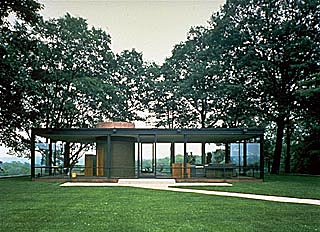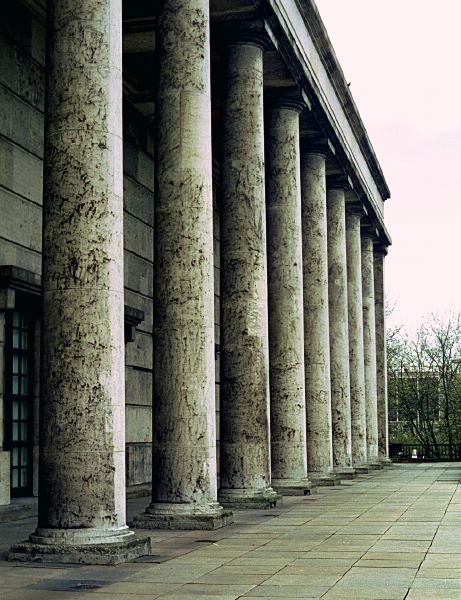|
Hitler was not the first, nor will he be the last to try to harness brick and mortar in order to weild his power.
In perhaps one of the most cunning manifestos on the impact of architecture, one Jeremy Bentham, writing in 1787,
describes a plan for "any establishment, in which persons of any description are to be kept under inspection."
In this panoptic (meaning, quite literally, a single view containing everything that is visible) world, all the people
contained therein are constantly under the gaze of figures residing in a central tower into which they cannot
see--never knowing if the guards are present or not, they must always assume they are being watched, being witnessed. The idea has
since come to be realized in a number of different ways, but none so precisely as the Stateville Correctional
Center in Crest Hill, Illinois (pictured above).
Michel Foucault, a French philosopher and social
critic, writes at length about the phenomenon of the Panopticon in his book Discipline and Punish
(orig. in French, Surveiller et Punir), as it can be seen in the broader context of society. Drawing
on a long and gruesome history of punishment and tortures, both public and private, Foucault arrives at modern times
with the idea that we are all simultaneously acting as the one watching and the one being watched, that the
architecture of our world thrusts us into the dual position of fearing the gaze and at the same using it against
those around us.
 Surveillance cameras
were recently installed in various corners of DC, with many Americans crying foul, but
in no other country than Britain (the homeland of the great Mr. Orwell himself) is there more
scrutiny by camera of the populous. Over 4 million cameras are installed in that tiny, island country, each one linked
to a immense network known popularly as CCTV (closed-circuit television). If a shop wants to install a camera where there isn't one
already, they must subscribe to CCTV and a camera is then added to the vast array that are already
scanning the citizenry.
Surveillance cameras
were recently installed in various corners of DC, with many Americans crying foul, but
in no other country than Britain (the homeland of the great Mr. Orwell himself) is there more
scrutiny by camera of the populous. Over 4 million cameras are installed in that tiny, island country, each one linked
to a immense network known popularly as CCTV (closed-circuit television). If a shop wants to install a camera where there isn't one
already, they must subscribe to CCTV and a camera is then added to the vast array that are already
scanning the citizenry.
But wasn't it also the great modern architects
of the 20th century who were building houses of glass and window into which all may see and inside of
which all may be seen? There is the Philip Johnson house pictured above, and the Villa Savoye of
Le Corbusier (see link below)--credited by many as being his masterwork if not one of the masterworks of all
20th century architecture. When viewing such spaces one is, of course, quickly reminded of the popular proverb:
“Qui a sa maison de verre,
Sur le voisin ne jette pierre.”
Proverbes en Rimes (1664) [translation below]
And so, with one last thought from Mr. Bentham, I close: "What would you say, if by the gradual adoption and diversified application of this single principle, you should see a new scene of things spread itself over the face of civilized society? - morals reformed, health preserved, industry invigorated, instruction diffused, public burthens[sic] lightened, economy seated as it were upon a rock, the gordian[sic] knot of the poor-laws not cut but untied - all by a simple idea in architecture?"
Related Links:
Jeremy Bentham's Panopticon (full text)
Manifesto of Futurist Architecture, written by
Antonio Sant’Elia (please be warned, there is some strong metaphor usage here and the Futurists were admitted facists)
Fairly recent article on the expansion of CCTV throughout Britain with mild implications about the implementation of facial recognition software
A page with images of Le Corbusier's Villa Savoye, and then if you click here you can visit the Le Corbusier Foundation site.
One interptertation and two different sites giving the origin and meaning of the phrase, "Those who live in glass houses shouldn't throw stones." Interpretation (quoted from clichesite.com) "If you have weaknesses, you should not point out the weaknesses of your opponents." Sites: 1, 2. |

 Surveillance cameras
were recently installed in various corners of DC, with many Americans crying foul, but
in no other country than Britain (the homeland of the great Mr. Orwell himself) is there more
scrutiny by camera of the populous. Over 4 million cameras are installed in that tiny, island country, each one linked
to a immense network known popularly as CCTV (closed-circuit television). If a shop wants to install a camera where there isn't one
already, they must subscribe to CCTV and a camera is then added to the vast array that are already
scanning the citizenry.
Surveillance cameras
were recently installed in various corners of DC, with many Americans crying foul, but
in no other country than Britain (the homeland of the great Mr. Orwell himself) is there more
scrutiny by camera of the populous. Over 4 million cameras are installed in that tiny, island country, each one linked
to a immense network known popularly as CCTV (closed-circuit television). If a shop wants to install a camera where there isn't one
already, they must subscribe to CCTV and a camera is then added to the vast array that are already
scanning the citizenry.